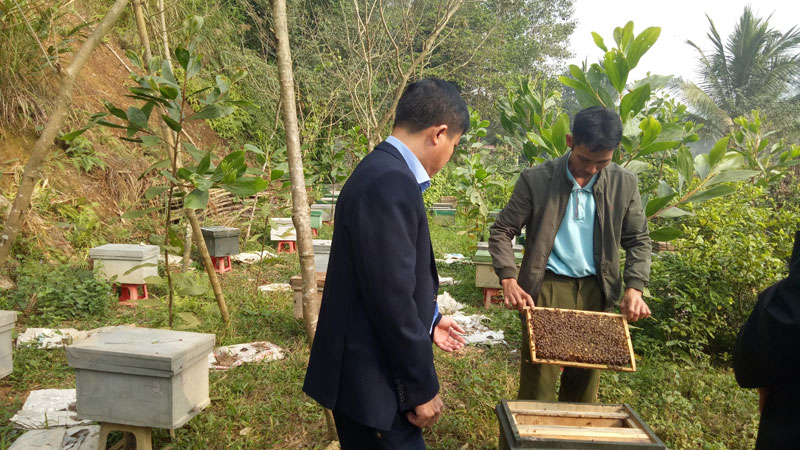
(HBO) - Van Tien beekeeping cooperative, Dan Ha commune (Ky Son) was established and gone into operation to mobilize the resources from the beekeepers in the commune to build a brand for the honey products.

Mr. Nguyen Luong Thuy's family, Van Tien hamlet, Dan Ha commune (Ky Son)
raised over 200 flocks of bees, getting an income of over 200 million VND a
year.
In recent years, beekeeping has gradually become a profession in Dan Ha
commune. With the advantage of a forest area of nearly 200 hectares in the
commune which is convenient for beekeeping development, the commune has rich
beekeepers. The household raising most bees is Mr. Tran Van Thien's household.
His family raises 800 flocks of bees.
Mr. Thuy said "I have noticed that beekeepers in the region are lacking 3
basic things. They are the investment capital, the experience and the market to
consume bee products. When the flocks of bees are full, it is necessary to be
separated, and the beekeepers need to cooperate and link together to build a
strong brand for the products, not only for the domestic consumption but also
for export.
To find the answer to "need and enough" question for the
beekeepers, he has met the most experienced beekeepers to discuss and look for
the direction for beekeeping. When the idea of establishing a bee-keeping
cooperative was supported, he continued to go to some beekeepers in the area to
mobilize people to join the beekeeping cooperative. Basing on this, in July 2018, Van Tien
beekeeping cooperative was established with 11 members. The cooperative has a
total of over 1,000 flocks of honey bees.
Mr. Nguyen Manh Sau, the chairman of Dan Ha Commune People's Committee says
that raising bees for honey is not a new job in Dan Ha. Previously, beekeepers
in the commune were mainly in small forms and the products were to serve the
family's needs only. Recognizing the effectiveness of beekeeping model, many
households have actively learned and implemented the model because it brings the
economic benefits and creates jobs at leisure time. There have been 1,680
flocks of bees for honey. It is estimated to collect about 15 tons of honey a
year, bringing the income of more than 2 billion VND.
According to data from the Hoa Binh Provincial Party Committee, the industrial production index for the first six months of 2025 is estimated to have increased by 20% compared to the same period last year. This marks the highest year-on-year growth rate for this period since 2020.
In the first six months of 2025, Hoa Binh province’s export turnover was estimated at 1.145 billion USD, marking an 18.11% increase compared to the same period in 2024. Import turnover was estimated at $ 804 million, a 17.15% increase, which helped the province maintain a positive trade balance.
The lives of the ethnic minority farmers in Tan Lac district have gradually improved thanks to the new directions in agricultural production. This is a testament to the collective strength fostered through the professional associations and groups implemented by various levels of the district’s Farmers’ Union.
With the motto the "product quality comes first,” after nearly one year of establishment and operation, Muong village’s Clean Food Agricultural and Commercial Cooperative, located in Cau Hamlet, Hung Son Commune (Kim Boi district), has launched reputable, high-quality agricultural products to the market that are well-received by consumers. The products such as Muong village’s pork sausage, salt-cured chicken, and salt-cured pork hocks have gradually carved out a place in the market and they are on the path to obtaining the OCOP certification.
In the past, the phrase "bumper harvest, rock-bottom prices" was a familiar refrain for Vietnamese farmers engaged in fragmented, small-scale agriculture. But today, a new spirit is emerging across rural areas of Hoa Binh province - one of collaboration, organisation, and collective economic models that provide a stable foundation for production.
Maintaining growing area codes and packing facility codes in accordance with regulations is a mandatory requirement for agricultural products to be eligible for export. Recently, the Department of Agriculture and Environment of Hoa Binh province has intensified technical supervision of designated farming areas and packing facilities to safeguard the "green passport" that enables its products to access international markets.



